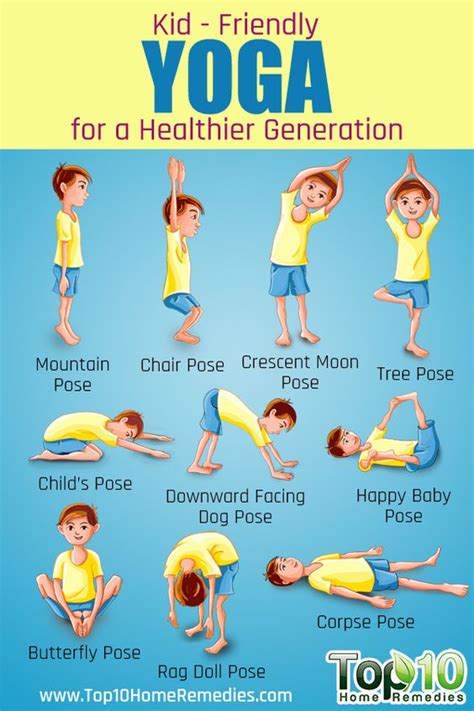Creative and Fun Yoga Poses for Kids to Practice at Home
Yoga is a great way for kids to develop strength, flexibility, and mindfulness—all while having fun! In this guide, we’ll explore a variety of fun yoga poses for kids that they can easily do at home. By making yoga enjoyable, children can improve their physical health and mental well-being, while also gaining tools for stress relief and relaxation. Whether they are beginners or more experienced, these yoga poses can be adapted to fit the needs of every child.
Introduction: Why Yoga Is Important for Kids
Yoga isn’t just for adults; it’s a fantastic practice for children as well. It offers physical benefits such as increased flexibility, strength, and coordination, but it also supports mental health by promoting calmness, self-regulation, and focus. Introducing yoga to kids early on can provide lifelong skills for managing stress and staying active.
Unlike competitive sports, yoga for children focuses on self-expression, making it accessible and enjoyable for all kids, regardless of their athletic abilities. At home, yoga becomes a family-friendly activity that can be done anytime, with little equipment needed. Let’s dive into some key yoga poses that are not only fun but also simple enough for kids to practice at home!
Key Concepts of Kids Yoga
- Imagination: Many yoga poses for kids involve playful names, like “Cat-Cow” or “Downward Dog,” which make the practice more engaging. Incorporating stories or themes into the poses encourages imagination and creativity.
- Mindfulness: Yoga helps kids learn mindfulness, which enhances focus and emotional regulation. It’s about being present in the moment and paying attention to their body’s movements.
- Body Awareness: As children move through different poses, they develop a greater understanding of their body, improving their motor skills and spatial awareness.
- Balance: Practicing yoga helps with both physical and emotional balance, as kids learn to hold poses and stay calm during challenging moments.
Historical Context: Yoga’s Roots and Its Adaptation for Kids
Yoga has ancient roots in India, dating back over 5,000 years. Originally a spiritual practice, it has evolved into a more physical and mental discipline over the centuries. While yoga for adults can be more intense, kids’ yoga focuses on simplicity and fun, using poses that are often adapted from traditional yoga practices to make them more accessible and entertaining.
The adaptation of yoga for children started gaining popularity in the 20th century. Educators and health professionals recognized the benefits of yoga in improving concentration, emotional health, and physical fitness in children. Now, yoga is commonly used in schools, homes, and wellness programs to support child development.
Current State Analysis: The Rise of Yoga at Home
With more parents and caregivers focusing on physical and mental well-being, yoga has become a go-to activity that can be done indoors, especially with the rise of at-home exercise during recent global events. Many parents are turning to online yoga videos for kids, apps, and books to guide their children in yoga sessions. The accessibility of yoga at home makes it an attractive option for families looking for fun and healthy activities that promote well-being without needing expensive equipment or gym memberships.
Practical Applications: Yoga Poses for Kids at Home
Here’s a list of simple and fun yoga poses for kids to practice at home. These poses are easy to follow and designed to keep kids engaged while building their strength and flexibility.
- Tree Pose (Vrksasana): This balancing pose is great for improving focus and balance. Kids can imagine they are a tall tree, rooted to the ground, swaying gently in the wind.
- Cat-Cow Pose (Marjaryasana-Bitilasana): This pose helps children stretch their spine while encouraging movement coordination. They can pretend to be cats stretching out in the sun, then arch like a cow.
- Downward-Facing Dog (Adho Mukha Svanasana): A great pose for strengthening arms and legs, kids can pretend to be playful dogs stretching out.
- Cobra Pose (Bhujangasana): Kids can imagine they’re a cobra rising from the ground. This pose strengthens the back and improves posture.
- Happy Baby Pose (Ananda Balasana): A calming pose where kids can lay on their backs and grab their feet, much like a playful baby.
- Butterfly Pose (Baddha Konasana): Sitting with feet together, kids can pretend they are butterflies flapping their wings. This pose is great for stretching hips and inner thighs.
Case Studies: Real-Life Examples of Kids Practicing Yoga
Here are a few examples of how kids are incorporating yoga into their daily routines:
- Jade, Age 7: After starting yoga with her mom, Jade loves doing Tree Pose and Downward Dog every morning. Her mom says it has helped Jade improve her concentration in school.
- Logan, Age 10: Logan, who has always been very active, enjoys using yoga to stretch after playing soccer. His favorite pose is the Cobra because it helps with his back pain.
- Amara, Age 5: Amara’s preschool introduced yoga, and she loves the Butterfly Pose, which she practices every day after school. Her parents notice she’s calmer and less fidgety.
Stakeholder Analysis: Who Benefits from Kids’ Yoga?
The following groups greatly benefit from incorporating yoga into kids’ lives:
- Parents and Caregivers: Yoga offers a bonding activity while supporting their child’s physical and mental health.
- Schools and Educators: Yoga can be integrated into the classroom to promote mindfulness, focus, and emotional regulation.
- Health Professionals: Yoga is often recommended by pediatricians and mental health experts as part of a holistic approach to wellness for children.
Implementation Guidelines: How to Get Kids Started with Yoga at Home
Here are some tips to help get your kids started with yoga:
- Start Small: Begin with short, simple sessions. 5-10 minutes is plenty for young children.
- Incorporate Play: Make it fun! Add storytelling, animal sounds, or pretend scenarios to keep them engaged.
- Use Visual Aids: Utilize yoga cards or apps designed for kids to help guide them through poses.
- Encourage Consistency: Set a regular time for yoga practice, such as before bed or after school.
Ethical Considerations: Respecting Kids’ Limits
It’s important to ensure that yoga remains a positive and enjoyable experience for children. Pushing them too hard or expecting perfection can create unnecessary stress. Instead, focus on their progress, encouraging them to listen to their bodies and rest when needed. It’s also important to avoid using yoga as a punishment; instead, it should be seen as a fun and relaxing activity.
Limitations and Future Research
While there is a growing body of evidence supporting the benefits of yoga for kids, more research is needed to fully understand its long-term impact on children’s mental and physical development. Future studies could examine the effects of different yoga practices on specific populations, such as children with ADHD or anxiety. Additionally, research could explore how integrating yoga into school curricula influences academic performance and emotional well-being over time.
Expert Commentary on the Impact of Yoga for Kids
Experts agree that yoga offers a wide range of benefits for children, from improved physical health to enhanced mental clarity and emotional regulation. According to pediatric yoga specialists, incorporating yoga into kids’ routines can help them develop lifelong habits of self-care and mindfulness. In today’s fast-paced world, yoga provides children with valuable tools to manage stress, build confidence, and maintain balance in both body and mind.








